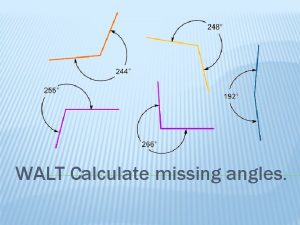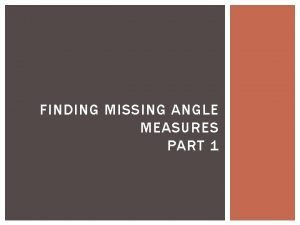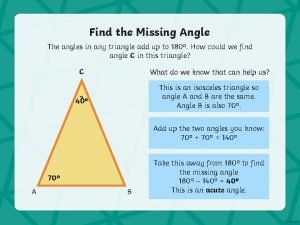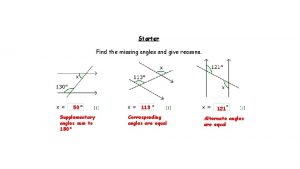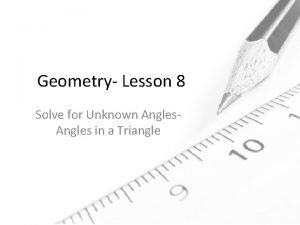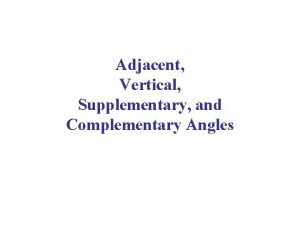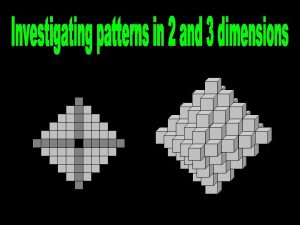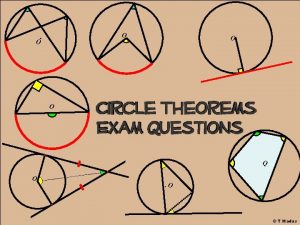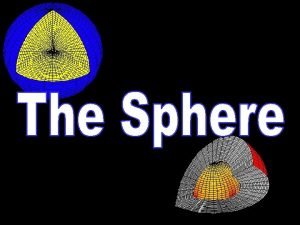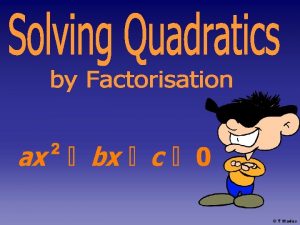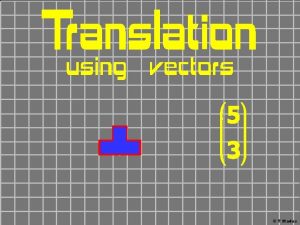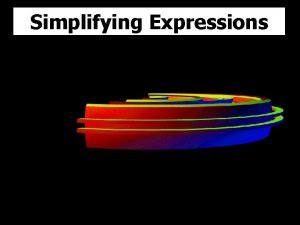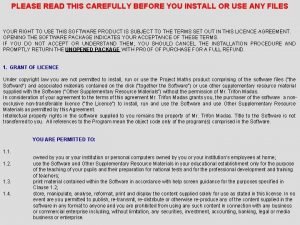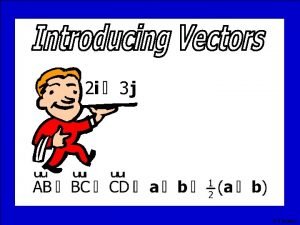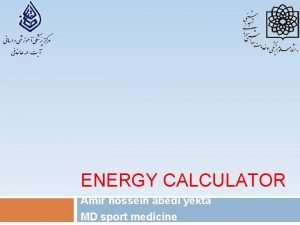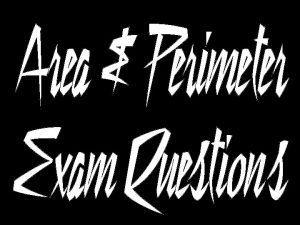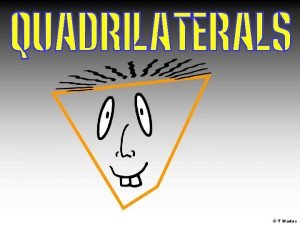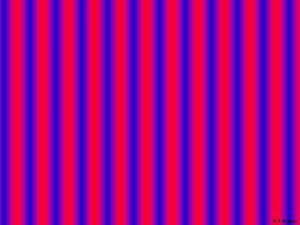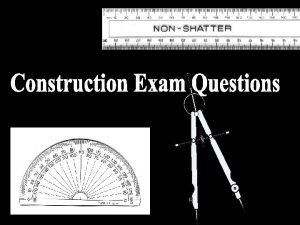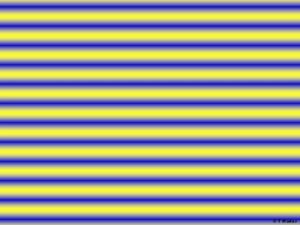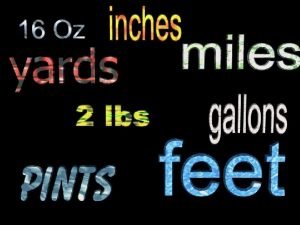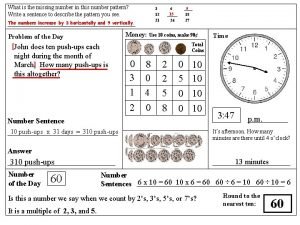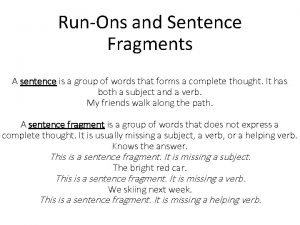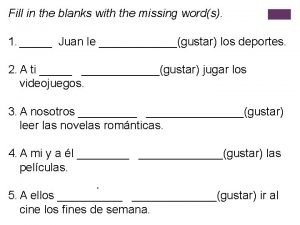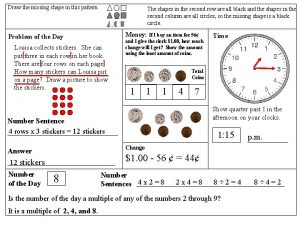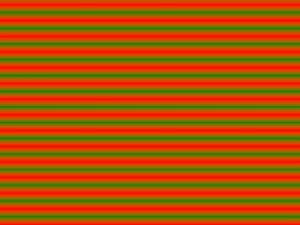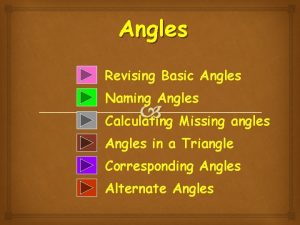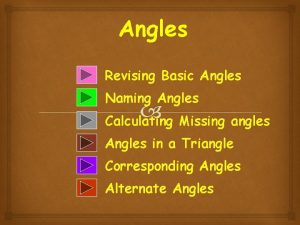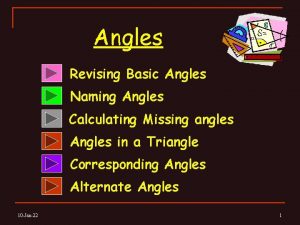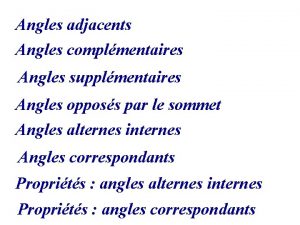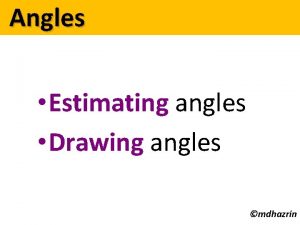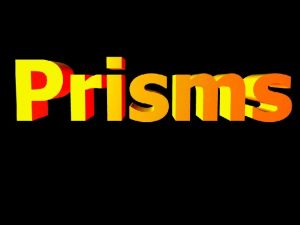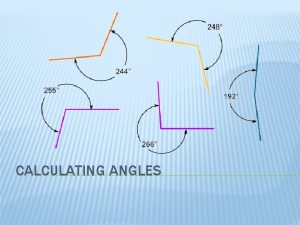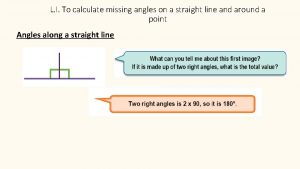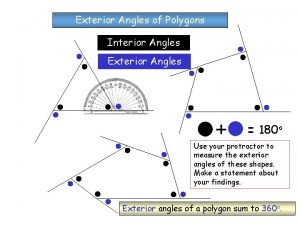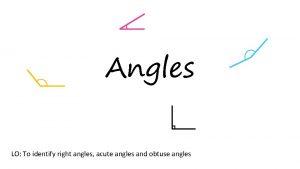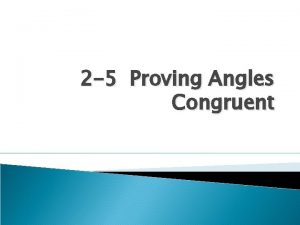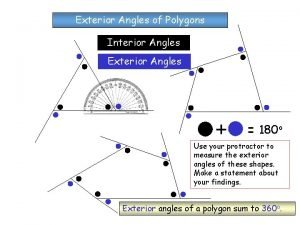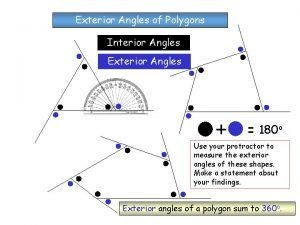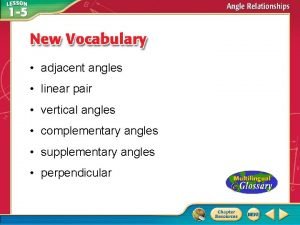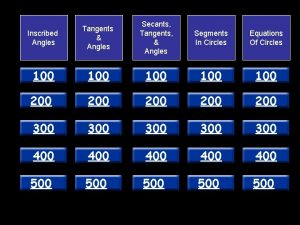T Madas T Madas Calculate the missing angles


















































































































- Slides: 114

© T Madas

© T Madas

Calculate the missing angles in each triangle 70° 50° 65° 55° © T Madas

© T Madas

One of the angles of an isosceles triangle is 64°. What are the sizes of the other two angles? [You must show that there are 2 different possibilities] 1 st possibility 2 nd possibility 52° 64 + 64 128 64° 180 – 128 52 58° 180 – 64 116 58° 116 ÷ 2 = 58° © T Madas

© T Madas

Calculate the angle marked as x. 49° 41° 49° x © T Madas

© T Madas

Calculate the angle marked as x. 61° 21° 69° 29° 50° x © T Madas

© T Madas

Calculate the angle marked as x 50° 130° 20° 70° ° 0 x 3 © T Madas

© T Madas

Calculate three angles of the triangle 70 ° 140° 40 ° 70 ° Calculate the angle marked with x 55 ° 110° x 70 ° 55 ° © T Madas

© T Madas

Calculate the angle marked with x 292° x 68 ° 136° 44 ° 68 ° © T Madas

© T Madas

In the following diagram RBAC = 28° and AC = BD Calculate the angle marked as x x 84° B 56° 68° D 28° C 28° 124 ° 56° A © T Madas

© T Madas

One of the angles of a rhombus is 47°. Calculate the angle marked as x. 47 + 47 94 47° x 133° 360 – 94 266 ÷ 2 = 133° • Opposite angles in a parallelogram are equal • A rhombus is a special parallelogram • Angles in any quadrilateral add up to 360° © T Madas

© T Madas

In the following diagram Calculate: 1. REFD 2. RDCF 3. RBEF RBAC = 90°, RADF = 71° and RBFE = 36° B REFD = 144° RDCF =35° E 36 ° F 14 4° 71° A 36 ° 109° D 35° C © T Madas

In the following diagram Calculate: 1. REFD 2. RDCF 3. RBEF RBAC = 90°, RADF = 71° and RBFE = 36° B 19° REFD = 144° E RDCF =35° 36 RBEF = ° F 14 4° 71° A 36 ° 109° D 35° C © T Madas

In the following diagram Calculate: 1. REFD 2. RDCF 3. RBEF RBAC = 90°, RADF = 71° and RBFE = 36° B 19° REFD = 144° RDCF =35° 12 E 5° 36 RBEF = 125° ° F 14 4° 71° A 36 ° 109° D 35° C © T Madas

© T Madas

The following shape has rotational symmetry of order 8. One angle is marked on the diagram. 1. Calculate the size of angle x 2. Calculate the size of angle y 360° ÷ 8 = 45° 360° 45° x y 21° © T Madas

The following shape has rotational symmetry of order 8. One angle is marked on the diagram. 1. Calculate the size of angle x 2. Calculate the size of angle y 360° ÷ 8 = 45° 21° + 45° = 66° 45° 114° y ° 1 2 180° – 66° = 114° 21° © T Madas

© T Madas

A farm gate consists of three parallel planks of wood with a metal bar running diagonally for extra support, as shown in the diagram. Calculate the angles x, y and z. y x z x = 30° x and the 30° angle are ALTERNATE ANGLES © T Madas

A farm gate consists of three parallel planks of wood with a metal bar running diagonally for extra support, as shown in the diagram. Calculate the angles x, y and z. y x z x = 30° y and the 30° angle are CORRESPONDING ANGLES © T Madas

A farm gate consists of three parallel planks of wood with a metal bar running diagonally for extra support, as shown in the diagram. Calculate the angles x, y and z. ALTERNATE ANGLES 30° y x 30° z x = 30° y = 30° z = 150° © T Madas

© T Madas

ABCD is a trapezium RADB = 90° RDBE = 25° and RCEB = 55° 1. Calculate RABD 2. Calculate RDAB 3. Calculate RBDC D E C 55 ° 25 ° A B © T Madas

ABCD is a trapezium RADB = 90° RDBE = 25° and RCEB = 55° 1. Calculate RABD 30° 2. Calculate RDAB 60° 3. Calculate RBDC D E C 55 ° Alternate Angles 25 ° 60° 30° A B Angles of a triangle © T Madas

ABCD is a trapezium RADB = 90° RDBE = 25° and RCBE = 55° 1. Calculate RABD 30° 2. Calculate RDAB 60° 3. Calculate RBDC 30° E D 30° C 55 ° Alternate Angles 25 ° 60° A 30° B © T Madas

© T Madas

A parallelogram ABCD, its diagonals and some of its angles are shown in the diagram below. 1. Calculate the four angles of the parallelogram. 2. Using the properties of parallelograms (including special parallelograms), explain why this drawing is impossible. B 55° A 20° C ° 50 D RCAD = RBCA: alternating angles © T Madas

A parallelogram ABCD, its diagonals and some of its angles are shown in the diagram below. 1. Calculate the four angles of the parallelogram. 2. Using the properties of parallelograms (including special parallelograms), explain why this drawing is impossible. B 55° 50 A 20° ° 20° D C ° 50 we could use: opposite angles in any parallelogram are equal or RCAD = RBCA: alternating angles RACD = RBAC: alternating angles © T Madas

A parallelogram ABCD, its diagonals and some of its angles are shown in the diagram below. 1. Calculate the four angles of the parallelogram. 2. Using the properties of parallelograms (including special parallelograms), explain why this drawing is impossible. B 20° 55° 50 A ° 110° 20° 70 + 70 140 D 360 – 140 220 C ° 50 we could use: opposite angles in any parallelogram are equal or 220 ÷ 2 = 110° © T Madas

A parallelogram ABCD, its diagonals and some of its angles are shown in the diagram below. 1. Calculate the four angles of the parallelogram. 2. Using the properties of parallelograms (including special parallelograms), explain why this drawing is impossible. B 55° 50 A 55° ° 20° 110° D C ° 50 there is no parallelogram with only one diagonal bisecting its angles In any parallelogram both diagonals bisect their angles: rhombus, square both diagonals do not bisect their angles: rectangle , ordinary parallelogram only one diagonal bisect its angles: NONE Can you think of a quadrilateral where only one diagonal bisect its angles? © T Madas

© T Madas

Work the missing angle if and is a rectangle is equilateral E A x 50° D 40° 20° G F 120° 60° B C © T Madas

© T Madas

If is equilateral, is a rectangle and F, A and C lie on a straight line show that is isosceles F A E 30° 60° D 30° 120° 60° B C © T Madas

© T Madas

Find the value of the angle marked in purple 55° 75° 125° 75° 105° 50° © T Madas

© T Madas

Find the value of x and hence calculate these two angles 2 x 3 x 3 x + 2 x = 90° 5 x = 90° c c 2 x x = 18° © T Madas

Find the value of x and hence calculate these two angles 36° 3 x + 2 x = 90° 5 x = 90° c c 54° x = 18° © T Madas

© T Madas

Find the value of angle x ONLY 2 a b b x 90° 2 a + 2 b = 180° a + c a a b = 90° © T Madas

© T Madas

Find the value of the angle marked in purple 52° 100° 48° © T Madas

© T Madas

Find the value of the angle marked in purple 27° 275° 58° © T Madas

© T Madas

Find the value of x and hence calculate these two angles 3 x 108° 2 x 72° Alternate Angles Straight Line 3 x + 2 x = 180° 5 x = 180° c c 2 x x = 36° © T Madas

© T Madas

Two equilateral triangles overlap each other, forming angles of 50° and 80° with the straight line AB as shown in the diagram. What is the angle marked as x ? solution x 50° 60° 70° A 80° 70° 60° 50° 40° 70° B © T Madas

© T Madas

Four lines cross each other as shown in the diagram below. Four triangles are created by connecting the endpoints of these lines. What is the sum of the 8 angles shown in yellow? … the angles in a triangle add up to 180° … solution … the 12 angles of the 4 triangles must add up to … … 4 x 180° = 720° … … the green angles are vertically opposite to the 4 red angles of the quadrilateral … … the angles of a quadrilateral add up to 360° … … the yellow angles add up to… … 720° – 360° = … 360° © T Madas

© T Madas

The figure below shows a pentagon ABCDE. REAB = RABC = 105° and RBCD = RDEA = 100°. Calculate the angle REDC. D x E … split the pentagon into 3 triangles … C 100° … the angles of a triangle add up to 180°… … the angles of the pentagon must add up to… 105° A … 180° x 3 = 540°… 105° B … the four given angles add up to 410°… … REDC = 130° © T Madas

© T Madas

A regular heptagon (7 sided polygon) ABCDEFG is drawn below. Calculate the size of RAOC, giving your answer to 3 significant figures. A 360° ÷ 7 ≈ 51. 4286° B G 51. 4286° x 2 ≈ 103° [3 s. f. ] O F C E D © T Madas

© T Madas

A regular hexagon is shown below. Calculate the angles marked as x, y and z. 360° ÷ 6 = 60° 12 0° 30 z° 60° y 120° x 60° © T Madas

© T Madas

Three regular pentagons are placed in the way shown below so that they all share one vertex. Calculate the angle marked as x 54 ° 72 ° 54108° ° 108° x 36° © T Madas

© T Madas

A regular polygon has exterior angle of 40°. How many sides does it have? exterior angle = 360° n This is an easy problem… … but you are under exam pressure and you forgot this formula…. … in fact good mathematicians do not memorise this formula… … go back to basics © T Madas

A regular polygon has exterior angle of 40°. How many sides does it have? 40° 70° 360 ÷ 40 = 9 sides 40° © T Madas

© T Madas

Part of a regular polygon is shown below. Its exterior angle is 20° How many sides does it have? Calculate the angle marked as y. The exterior angle of an n-sided regular polygon is given by: 360° 20 ° n 20 ° 360 ÷ 20 = 18 sides y ° 20 20° The exterior angle of an n-sided regular polygon is equal to its central angle. y = 80° © T Madas

© T Madas

A tessellation of squares and regular octagons is shown opposite. Calculate the angle marked as x. x x angles around a point add up to … … 360° subtracting the right angle gives … … 270° dividing by 2 gives … 135° x = 135° © T Madas

© T Madas

Regular dodecagons tessellate with equilateral triangles as shown opposite. Use this fact to calculate the interior angle of a regular dodecagon. angles around a point add up to … … 360° subtracting the 60° angle gives … … 300° 60° x x dividing by 2 gives … 150° The interior angle of a regular dodecagon is 150° © T Madas

© T Madas

A regular enneagon, (9 -sided polygon), is drawn below. Calculate the angles marked as x and y. 360° ÷ 9 = 40° x 70° 40° 70° y 180° – 40° = 140° ÷ 2 = 70° x = 140° y = 40° © T Madas

© T Madas

Calculate the exterior angle of a regular pentagon 360° ÷ 5 = 72° 180° – 72° = 108° ÷ 2 = 54° 72° 54° 54° 72° © T Madas

© T Madas

The diagram below shows part of a tessellation consisting of a regular octagon and a square. Show by a calculation that a regular hexagon cannot be used to fit the space between the square and the octagon. What regular polygon can fit instead? 360° ÷ 8 = 45° 180° – 45° = 135° 5° 13 135° ÷ 2 = 67. 5° 45° 5°. 7 6 © T Madas

The diagram below shows part of a tessellation consisting of a regular octagon and a square. Show by a calculation that a regular hexagon cannot be used to fit the space between the square and the octagon. What regular polygon can fit instead? 360° ÷ 6 = 60° 180° – 60° = 120° 5° 13 135° 120° ÷ 2 = 60° 120° 60° 135° + 90° = 225° 360° – 225° = 135° 45° 5°. 7 6 The angle between the square and the octagon is 135° while the interior angle of a regular hexagon is 120°. Therefore a regular hexagon will not fit. © T Madas

The diagram below shows part of a tessellation consisting of a regular octagon and a square. Show by a calculation that a regular hexagon cannot be used to fit the space between the square and the octagon. What regular polygon can fit instead? 360° ÷ 6 = 60° 180° – 60° = 120° ÷ 2 = 60° 120° 5° 13 60° 135° + 90° = 225° 360° – 225° = 135° 45° 5°. 7 6 The angle between the square and the octagon is 135° while the interior angle of a regular hexagon is 120°. Therefore a regular hexagon will not fit. © T Madas

The diagram below shows part of a tessellation consisting of a regular octagon and a square. Show by a calculation that a regular hexagon cannot be used to fit the space between the square and the octagon. What regular polygon can fit instead? 360° ÷ 6 = 60° 180° – 60° = 120° ÷ 2 = 60° 120° 5° 13 60 ° 135° + 90° = 225° 360° – 225° = 135° 45° 5°. 7 6 The angle between the square and the octagon is 135° while the interior angle of a regular hexagon is 120°. Therefore a regular hexagon will not fit. © T Madas

5° 13 135° The diagram below shows part of a tessellation consisting of a regular octagon and a square. Show by a calculation that a regular hexagon cannot be used to fit the space between the square and the octagon. What regular polygon can fit instead? 45° 5°. 7 6 © T Madas

5° 13 135° The diagram below shows part of a tessellation consisting of a regular octagon and a square. Show by a calculation that a regular hexagon cannot be used to fit the space between the square and the octagon. What regular polygon can fit instead? 45° 5°. 7 6 Another a regular octagon can fit. © T Madas

© T Madas

The sides of a regular pentagon are extended until they form the star shape shown below. Calculate the size of the angles marked as α and β. φ φ c c c α The central angle of a regular pentagon is given by: θ β 360° ÷ 5 = 72° θ = 72° φ = 54° β = 108° © T Madas

The sides of a regular pentagon are extended until they form the star shape shown below. Calculate the size of the angles marked as α and β. θ φ φ β θ c c α The central angle of a regular pentagon is given by: 360° ÷ 5 = 72° θ = 72° φ = 54° β = 108° α = 36° © T Madas

© T Madas

The shape below has rotational symmetry of order 5 and each of the five quadrilateral “arrowheads” consists of two congruent isosceles triangles. Calculate the angles marked as x and y. … rotational symmetry of order 5 … 22 x ° 72° … each “arrowhead has been rotated about the centre of the shape though an angle of … y … 360° ÷ 5 = 72° … © T Madas

The shape below has rotational symmetry of order 5 and each of the five quadrilateral “arrowheads” consists of two congruent isosceles triangles. Calculate the angles marked as x and y. … rotational symmetry of order 5 … ° 22 25° x x 72° … each “arrowhead has been rotated about the centre of the shape though an angle of … y … 360° ÷ 5 = 72° … … 72° – 22 ° = 50° … … 50° ÷ 2 = 25° … … x = 25° … © T Madas

The shape below has rotational symmetry of order 5 and each of the five quadrilateral “arrowheads” consists of two congruent isosceles triangles. Calculate the angles marked as x and y. … 130° x 2 = 260° … ° 22 0° 3 1 25° 13 0° ° 25 y =100° … 360° – 260° = 100° … … y = 100° … © T Madas

The shape below has rotational symmetry of order 5 and each of the five quadrilateral “arrowheads” consists of two congruent isosceles triangles. Calculate the angles marked as x and y. … or we could use a circle theorem… ° 22 25° y =100° © T Madas

© T Madas

Calculate the area of a regular hexagon of side 8 cm, giving your answer to 3 significant figures. E D 4 30° h O F A 8 cm h h tan 30° = 4 4 h= tan 30° C 30° 4 cm 6. 928 60° = tan 30° h ≈ 6. 928 cm B © T Madas

Calculate the area of a regular hexagon of side 8 cm, giving your answer to 3 significant figures. E D O F C 6. 928 30° A 8 cm B © T Madas

There is a better method for this problem © T Madas

Calculate the area of a regular hexagon of side 8 cm, giving your answer to 3 significant figures. E F 8 60° C cm A 60° 8 cm 60° AT = 32 sin 60° AH = 192 sin 60° AH = 166 cm 2 [ 3 s. f. ] x 8 x sin 60° c = c O AT c D B © T Madas

© T Madas

A regular enneagon (9 -sided polygon) ABCDEFGHI is shown below. Calculate RICE. I A ● for the circle circumscribing H ● ● ● B G O C ● the enneagon: RIOE is a central angle RICE is an inscribed angle both angles correspond to the same arc. hence RICE is half of RIOE ● The central angle of a regular F D E enneagon is given by: 360° ÷ 9 = 40° ● RIOE = 160° ● hence RICE = 80° © T Madas

© T Madas

18 identical slabs in the shape of isosceles trapeziums fit tightly around a small fish pond as shown below. What is the smallest and what is the largest angle of these trapezoidal slabs? 360° ÷ 18 = 20° © T Madas

18 identical slabs in the shape of isosceles trapeziums fit tightly around a small fish pond as shown below. What is the smallest and what is the largest angle of these trapezoidal slabs? 360° ÷ 18 = 20° © T Madas

18 identical slabs in the shape of isosceles trapeziums fit tightly around a small fish pond as shown below. What is the smallest and what is the largest angle of these trapezoidal slabs? 360° ÷ 18 = 20° © T Madas

18 identical slabs in the shape of isosceles trapeziums fit tightly around a small fish pond as shown below. What is the smallest and what is the largest angle of these trapezoidal slabs? 80° 20° 80° 100° 80° 360° ÷ 18 = 20° © T Madas

© T Madas

A regular hexagon and a regular pentagon are made to overlap each other as shown in the diagram below. What is the size of the angle marked as x ? x © T Madas

A regular hexagon and a regular pentagon are made to overlap each other as shown in the diagram below. What is the size of the angle marked as x ? x How many degrees interior angle of a hexagon? is the regular … six equilateral triangles 120° 60° © T Madas

A regular hexagon and a regular pentagon are made to overlap each other as shown in the diagram below. What is the size of the angle marked as x ? © T Madas

A regular hexagon and a regular pentagon are made to overlap each other as shown in the diagram below. What is the size of the angle marked as x ? How many degrees interior angle of a pentagon? 72° 108° 54° is the regular … five isosceles triangles … 360° ÷ 5 = … … 72° … … 180° – 72° = … … 108° ÷ 2 = … … 54° … © T Madas

A regular hexagon and a regular pentagon are made to overlap each other as shown in the diagram below. What is the size of the angle marked as x ? x … split the overlapping pentagon into 3 triangles … … the angles of a triangle add up to 180°… 120° 108° … the angles of the pentagon must add up to… … 180° x 3 = 540°… … the four angles of the pentagon add up to 456°… … x = 84° © T Madas
 Opposite angle
Opposite angle Missing angle quadrilateral
Missing angle quadrilateral Missing angles of quadrilaterals worksheet
Missing angles of quadrilaterals worksheet Parallel line worksheet
Parallel line worksheet Inverse trig ratios and finding missing angles
Inverse trig ratios and finding missing angles How to find missing angles on a straight line
How to find missing angles on a straight line How to find missing angles in parallel lines
How to find missing angles in parallel lines What does x equal
What does x equal Missing angles puzzle
Missing angles puzzle Angles on a straight line worksheet grade 8
Angles on a straight line worksheet grade 8 45 45 90 triangle
45 45 90 triangle Angles reasons
Angles reasons Lesson 8 solve for unknown angles—angles in a triangle
Lesson 8 solve for unknown angles—angles in a triangle Cavosurface margin
Cavosurface margin Module 15 lesson 1 central angles and inscribed angles
Module 15 lesson 1 central angles and inscribed angles Vertical supplementary angles
Vertical supplementary angles Thẻ vin
Thẻ vin Tư thế ngồi viết
Tư thế ngồi viết Cái miệng xinh xinh thế chỉ nói điều hay thôi
Cái miệng xinh xinh thế chỉ nói điều hay thôi Các châu lục và đại dương trên thế giới
Các châu lục và đại dương trên thế giới Bổ thể
Bổ thể Từ ngữ thể hiện lòng nhân hậu
Từ ngữ thể hiện lòng nhân hậu Tư thế ngồi viết
Tư thế ngồi viết V. c c
V. c c Thể thơ truyền thống
Thể thơ truyền thống Làm thế nào để 102-1=99
Làm thế nào để 102-1=99 Hát lên người ơi alleluia
Hát lên người ơi alleluia Hổ đẻ mỗi lứa mấy con
Hổ đẻ mỗi lứa mấy con Diễn thế sinh thái là
Diễn thế sinh thái là đại từ thay thế
đại từ thay thế Vẽ hình chiếu vuông góc của vật thể sau
Vẽ hình chiếu vuông góc của vật thể sau Cong thức tính động năng
Cong thức tính động năng Tỉ lệ cơ thể trẻ em
Tỉ lệ cơ thể trẻ em Thế nào là mạng điện lắp đặt kiểu nổi
Thế nào là mạng điện lắp đặt kiểu nổi Lời thề hippocrates
Lời thề hippocrates Vẽ hình chiếu đứng bằng cạnh của vật thể
Vẽ hình chiếu đứng bằng cạnh của vật thể Quá trình desamine hóa có thể tạo ra
Quá trình desamine hóa có thể tạo ra Môn thể thao bắt đầu bằng chữ f
Môn thể thao bắt đầu bằng chữ f Sự nuôi và dạy con của hổ
Sự nuôi và dạy con của hổ Hình ảnh bộ gõ cơ thể búng tay
Hình ảnh bộ gõ cơ thể búng tay Dạng đột biến một nhiễm là
Dạng đột biến một nhiễm là điện thế nghỉ
điện thế nghỉ Biện pháp chống mỏi cơ
Biện pháp chống mỏi cơ Trời xanh đây là của chúng ta thể thơ
Trời xanh đây là của chúng ta thể thơ độ dài liên kết
độ dài liên kết Gấu đi như thế nào
Gấu đi như thế nào Thiếu nhi thế giới liên hoan
Thiếu nhi thế giới liên hoan Phối cảnh
Phối cảnh Một số thể thơ truyền thống
Một số thể thơ truyền thống Thế nào là hệ số cao nhất
Thế nào là hệ số cao nhất Sơ đồ cơ thể người
Sơ đồ cơ thể người Frameset trong html5
Frameset trong html5 So nguyen to
So nguyen to đặc điểm cơ thể của người tối cổ
đặc điểm cơ thể của người tối cổ Mật thư tọa độ 5x5
Mật thư tọa độ 5x5 Các châu lục và đại dương trên thế giới
Các châu lục và đại dương trên thế giới Glasgow thang điểm
Glasgow thang điểm ưu thế lai là gì
ưu thế lai là gì T madas
T madas Cubic sequence
Cubic sequence Madas papers
Madas papers T madas
T madas T madas
T madas T madas
T madas Area of semi sphere
Area of semi sphere T. madas
T. madas Facts about quadratics
Facts about quadratics Madas vectors
Madas vectors Simplifying expressions
Simplifying expressions T madas
T madas T madas
T madas Please read this carefully
Please read this carefully Madas vectors
Madas vectors T madas
T madas Amir hossein abedi
Amir hossein abedi T. madas
T. madas T.madas
T.madas Calculating percentages
Calculating percentages T.madas
T.madas Opposite of factorising
Opposite of factorising T. madas
T. madas Trapezoid vs rhombus
Trapezoid vs rhombus Madas math
Madas math Types of bearing in bridge
Types of bearing in bridge What is scalene isosceles and equilateral triangle
What is scalene isosceles and equilateral triangle Congruent
Congruent T madas
T madas T. madas
T. madas T madas
T madas T.madas
T.madas Tmadas
Tmadas T.madas
T.madas Cumulative frequency graph for discrete data
Cumulative frequency graph for discrete data T madas
T madas Cm naar m
Cm naar m T. madas
T. madas T madas
T madas Feet table
Feet table Madas vectors
Madas vectors Madas maths
Madas maths Rule of indices
Rule of indices T. madas
T. madas Quarter past 9
Quarter past 9 What is this
What is this Sentence with fragment
Sentence with fragment Fill in the blanks using the following words
Fill in the blanks using the following words What is a ratio table
What is a ratio table Draw the missing shape and explain how you know
Draw the missing shape and explain how you know Synthetic divison
Synthetic divison Missing equivalent fractions
Missing equivalent fractions What is missing
What is missing Discrete missing values spss
Discrete missing values spss What are we missing
What are we missing Ms missing model
Ms missing model Missing prepositions exercise
Missing prepositions exercise





